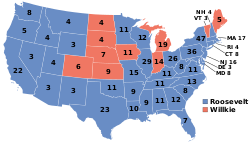| ||||||||||||||||||||||||||
All 13 North Carolina votes to the Electoral College | ||||||||||||||||||||||||||
|---|---|---|---|---|---|---|---|---|---|---|---|---|---|---|---|---|---|---|---|---|---|---|---|---|---|---|
| ||||||||||||||||||||||||||
 County Results
| ||||||||||||||||||||||||||
| ||||||||||||||||||||||||||
| Elections in North Carolina |
|---|
 |
The 1940 United States presidential election in North Carolina took place on November 5, 1940, as part of the 1940 United States presidential election. North Carolina voters chose 13 [2] representatives, or electors, to the Electoral College, who voted for president and vice president.
Contents
As a former Confederate state, North Carolina had a history of Jim Crow laws, disfranchisement of its African-American population and dominance of the Democratic Party in state politics. However, unlike the Deep South, the Republican Party had sufficient historic Unionist white support from the mountains and northwestern Piedmont to gain one-third of the statewide vote total in most general elections, [3] where turnout was higher than elsewhere in the former Confederacy due substantially to the state's early abolition of the poll tax in 1920. [4] Like Virginia, Tennessee and Oklahoma, the relative strength of Republican opposition meant that North Carolina did not have statewide white primaries, although certain counties did use the white primary. [5] North Carolina was one of five states that swung more Democratic compared to 1936, alongside New Hampshire, Rhode Island, Vermont, and Maine. [6]
In 1928, anti-Catholicism in the Outer Banks and growing middle-class urban Republicanism in Piedmont cities turned North Carolina to GOP nominee Herbert Hoover, [7] but this was sharply and severely reversed in the following decade beginning with Hoover's failed nomination of John Johnston Parker to the Supreme Court. [8] With the South having the highest unemployment in the nation and blaming its fate upon the North and Wall Street, [9] exceptionally heavy support was given to Democratic nominee Franklin D. Roosevelt in 1932 and 1936 everywhere except in a few rock-ribbed Republican mountain bastions. [7] Nevertheless, there was virtually no change to the state's social structure during the New Deal, [10] and the conservative “Shelby Dynasty” was strong enough to prevent any populist challenge so much as developing. [11] After the 1936 Democratic landslide and Roosevelt's failed “court-packing” plan, the state's leading federal officeholders came to increasingly oppose Roosevelt's policies. [10]
Although the state's relatively numerous Republicans were highly active in support of nominees Wendell Willkie and Senate Minority Leader Charles L. McNary, early analysts said Roosevelt remained so popular with the state's voters that there was no chance of the incumbent losing. [12] A poll in mid-October had Roosevelt carrying the state by a three-to-one margin after having given the incumbent 72 percent during the third week of September. [13]


